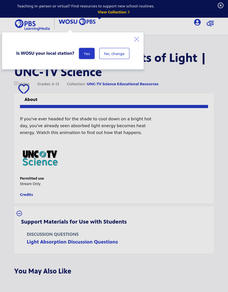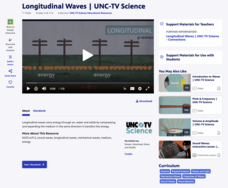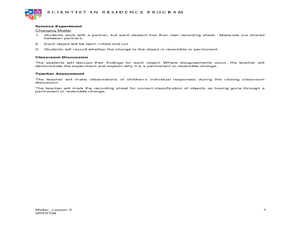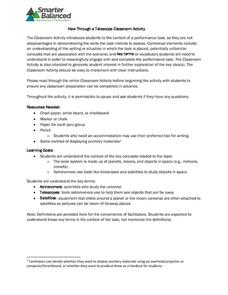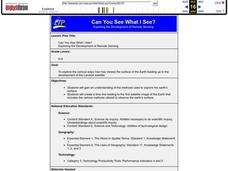Star Date
Solar System Scale Model Demonstration
Explore outer space and decorate your classroom with an astronomy project. Learners create a visual model with the creation of a scaled solar system using different sized balls.
Global Oneness Project
Relocating Residents: The Impact of Housing on Community
Sama Maydani and Sarah Kuck's film, Even the Walls, that explores the benefits and drawbacks of gentrification in downtown Seattle, asks viewers to consider how houses, apartment buildings, and outdoor spaces can be designed to build a...
PBS
Why Isn't There an Eclipse Every Month?
Searching for an eclipse activity that sends scholars over the moon? Try an interesting interactive to get their minds active! The resource, part of an extensive Space series from PBS Learning Media, uses modeling and data analysis to...
College Board
2009 AP® English Language and Composition Free-Response Questions
Exploration comes at a cost. A set of questions designed for the AP® English Language and Composition exam includes an argumentative prompt about the cost of space exploration. Writers review sources to develop their position before...
College Board
AP® English Language Special Focus: Using Sources
What is the most effective way to teach scholars how to write a research paper? Educators explore the topic with the AP® English Language and Composition exam resource. The reference material guides teachers in best practices for...
PBS
Light Absorption: Effects of Light | UNC-TV Science
Beat the summer heat by exploring the properties of color. Scientists view a video explaining the relationship between light absorption and energy transfer using variables including intensity, time, and wavelength. A multiple-choice...
PBS
Longitudinal Waves | UNC-TV Science
Discover whether sound travels in space and other fascinating science facts. Scientists explore energy transfer by longitudinal waves and learn about compression, rarefaction, amplitude, and wavelength while watching an animated video....
Curated OER
Making Regolith
You may not be able to take a field trip to the moon, but that doesn't mean your class can't study moon rocks. Using graham crackers as the moon's bedrock and powdered donuts as micrometeorites, young scientists simulate...
Curated OER
Our Amazing, Powerful Sun
Students examine where energy comes from and how it can be used. In this solar energy lesson students explore different aspects of the sun.
Curated OER
Play: It's Not Just For Kids
Students realize that play is an important part of life and in the effort to staying healthy. They explore the role of play in society. In addition, they illustrate listening and speaking strategies for different purposes that pertain to...
Curated OER
Galaxies
The first thing to note is that this lesson was written for use in a parochial school. Even if you are in a non-religious setting, however, the website exploration of galaxies and the accompanying worksheet make for an engaging...
Curated OER
What's The Weather?
Students explore the role that remote sensing plays in predicting our weather. Students investigate weather websites, and read about the three kinds of clouds. Students record and draw their observations in science journals.
Curated OER
Science Discovery Lesson: Air is All Around Us
Students explore the concept that air is everywhere. They assess that it can't be seen, but is all around us. Each student becomes aware that air takes up space and listen to the book, "Air is All Around You," by Franklin M. Branley.
Curated OER
Strange New Planet
Fourth graders gather data and simulate a Mars spacecraft mission using multi-sensory observations.
Curated OER
Spacemobiles
Aspiring astronauts construct a space vehicle using cylinders, cones, spheres, and rectangular prisms. This is an engaging method of learning about three-dimensional shapes. Note that the word cylinder is constantly misspelled in the...
NASA
Solar System Scale & Size
Use a variety of whole fruits to represent the different planets in the solar system to introduce scale sizes to your math or space science class. They follow suit by creating a non-scaled model of the solar system using specific-colored...
Curated OER
Learning from Light: The Big Bang
High schoolers explore what astronomers are able to examine our galaxy and universe by examining light. They explore in this sub-unit the formation of the universe, commonly called "The Big Bang," and it follows studying from the Light:...
Curated OER
Rhythmic Movement
Explore how waves move in the ocean with your young learners. Fill a two-liter bottle half full with colored water, and have the youngsters move the bottle to make waves inside of it. Then have them listen to the song "Wipe Out"....
Curated OER
Physical Changes to Matter
Pupils explore matter by conducting an in-class experiment. They experiment with water's various forms by melting and freezing water, identifying its new shape. These observations are recorded to supplement later discussion. They also...
Curated OER
Mass, Volume, and Weight
Students explore mass, volume, and weight. In this science and measurement lesson, students compare volume, mass, and weight after listening to the teacher's description of each. Students explore different scales and balances and...
Smarter Balanced
View Through a Telescope
Preparing for an assessment? Here's an activity that will ensure that all class members have the background knowledge they need to demonstrate their skills on a performance task related to the solar system and the tools astronomers use...
Curated OER
Art Careers
Students explore art careers. In this career education lesson plan, students explore three different learning stations which simulate several art careers. Students construct a career book after this activity.
Curated OER
Can You See What I See?
Learners gain an understanding of the methods used to explore the earth's surface. Students create a time line leading to the first satellite image of the Earth that includes the various methods utilized to observe the earth's surface.





